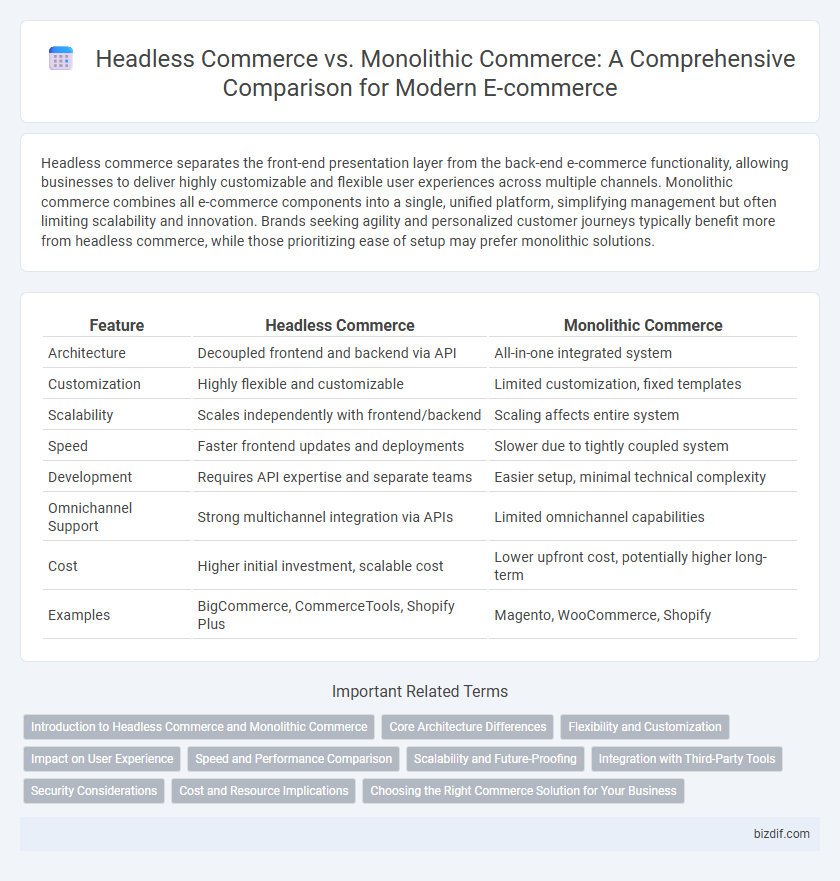Headless commerce separates the front-end presentation layer from the back-end e-commerce functionality, allowing businesses to deliver highly customizable and flexible user experiences across multiple channels. Monolithic commerce combines all e-commerce components into a single, unified platform, simplifying management but often limiting scalability and innovation. Brands seeking agility and personalized customer journeys typically benefit more from headless commerce, while those prioritizing ease of setup may prefer monolithic solutions.
Table of Comparison
| Feature | Headless Commerce | Monolithic Commerce |
|---|---|---|
| Architecture | Decoupled frontend and backend via API | All-in-one integrated system |
| Customization | Highly flexible and customizable | Limited customization, fixed templates |
| Scalability | Scales independently with frontend/backend | Scaling affects entire system |
| Speed | Faster frontend updates and deployments | Slower due to tightly coupled system |
| Development | Requires API expertise and separate teams | Easier setup, minimal technical complexity |
| Omnichannel Support | Strong multichannel integration via APIs | Limited omnichannel capabilities |
| Cost | Higher initial investment, scalable cost | Lower upfront cost, potentially higher long-term |
| Examples | BigCommerce, CommerceTools, Shopify Plus | Magento, WooCommerce, Shopify |
Introduction to Headless Commerce and Monolithic Commerce
Headless commerce separates the front-end presentation layer from the back-end e-commerce platform, enabling greater flexibility in customer experience customization across multiple channels. Monolithic commerce integrates both front-end and back-end into a single, unified system, offering simplicity and easier management for traditional online stores. Businesses choose headless commerce for scalability and omnichannel engagement, while monolithic commerce suits those seeking straightforward deployment and maintenance.
Core Architecture Differences
Headless commerce separates the frontend presentation layer from the backend commerce functionality, enabling greater flexibility in customizing user experiences across multiple channels through APIs. Monolithic commerce combines all functions--product management, checkout, and content delivery--into a single, tightly integrated platform, which can limit adaptability and scalability. The core architectural difference lies in headless commerce's decoupled design promoting agility, while monolithic commerce relies on a unified, all-in-one system structure.
Flexibility and Customization
Headless commerce offers unparalleled flexibility by decoupling the front-end presentation layer from the back-end commerce engine, enabling businesses to customize user experiences across multiple channels independently. In contrast, monolithic commerce platforms integrate front-end and back-end tightly, limiting customization options and slowing adaptability to market changes. This architectural difference empowers headless commerce to rapidly innovate and personalize customer journeys, essential for dynamic e-commerce environments.
Impact on User Experience
Headless commerce separates the frontend from the backend, enabling highly customizable and responsive user interfaces that adapt seamlessly across devices, significantly enhancing user experience. Monolithic commerce systems offer an integrated, all-in-one platform but often lack the flexibility to quickly implement design changes or personalized experiences, resulting in slower user interface updates. This architectural difference directly impacts site performance, load times, and the ability to deliver tailored content, making headless commerce a preferred choice for brands aiming to optimize customer journeys.
Speed and Performance Comparison
Headless commerce architecture enhances speed and performance by decoupling the front-end and back-end, allowing independent updates and faster load times through optimized APIs. Monolithic commerce systems often face slower performance due to tightly integrated components that create bottlenecks during high traffic or complex transactions. Businesses seeking scalable and rapid user experiences typically prefer headless commerce for its flexibility and superior response times.
Scalability and Future-Proofing
Headless commerce offers superior scalability by decoupling the front-end and back-end systems, enabling businesses to seamlessly integrate new technologies and handle increasing traffic without overhauling the entire platform. Monolithic commerce, with its tightly integrated architecture, often faces limitations in adapting to evolving market demands and scaling efficiently. Future-proofing is more robust in headless commerce, as its modular design allows continuous innovation and flexibility to adopt emerging digital trends and customer experiences.
Integration with Third-Party Tools
Headless commerce architecture allows seamless integration with multiple third-party tools, providing greater flexibility for customizing user experiences across various devices and platforms. Monolithic commerce platforms often have limited integration capabilities due to their all-in-one design, which can restrict the use of specialized third-party services. Choosing headless commerce enables businesses to leverage advanced APIs and connect with CRM, ERP, and marketing automation tools more efficiently, enhancing overall operational agility.
Security Considerations
Headless commerce offers enhanced security by decoupling the front-end from the back-end, reducing the attack surface and enabling more targeted security protocols. Monolithic commerce systems, while traditionally integrated, may present higher risks due to their single architecture point, making them more vulnerable to widespread breaches. Implementing API security measures and continuous monitoring is critical in headless setups to protect customer data and transaction integrity.
Cost and Resource Implications
Headless commerce often involves higher initial development costs due to the need for separate front-end and back-end systems but offers long-term savings through flexibility and scalability in resource allocation. Monolithic commerce typically has lower upfront expenses with an all-in-one platform but may incur increased costs over time because of limited customization and vendor lock-in. Businesses must weigh the trade-offs between initial investment and ongoing operational expenses when choosing the optimal e-commerce architecture.
Choosing the Right Commerce Solution for Your Business
Headless commerce offers unparalleled flexibility by decoupling the front-end and back-end, enabling businesses to deliver personalized customer experiences across multiple channels. Monolithic commerce provides an all-in-one platform with streamlined management, ideal for companies seeking simplicity and quick deployment. Selecting the right commerce solution depends on your business's scale, customization needs, and long-term growth strategy to optimize user engagement and operational efficiency.
Headless Commerce vs Monolithic Commerce Infographic

 bizdif.com
bizdif.com